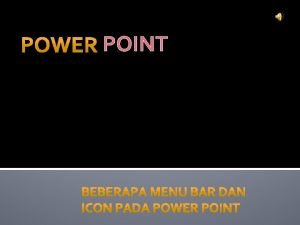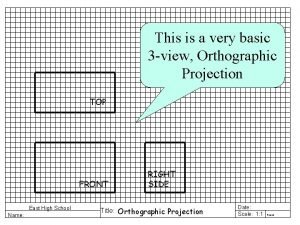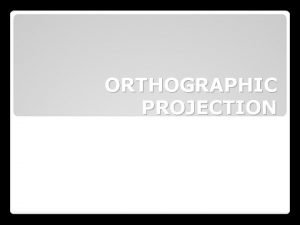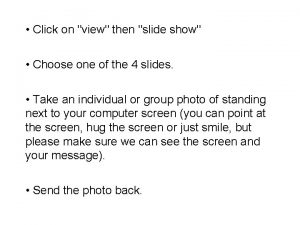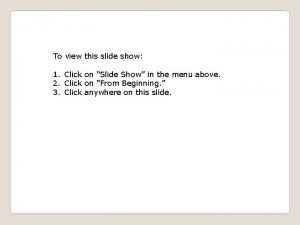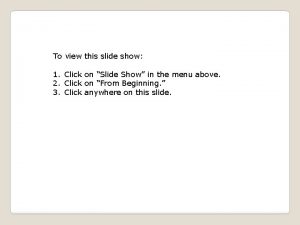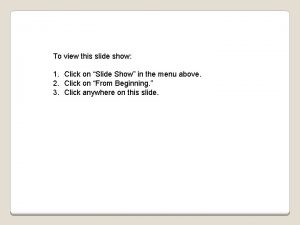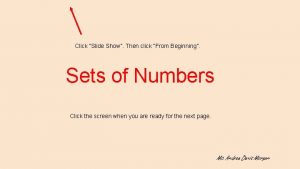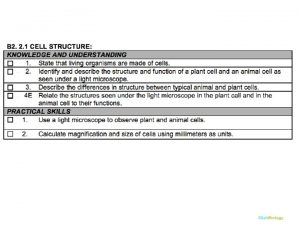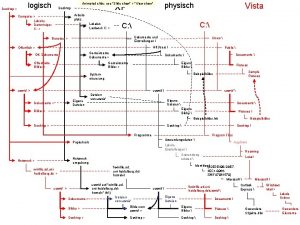To View this slide show 1 Click on





















- Slides: 21

To View this slide show: 1. Click on “Slide Show” above. 2. Click on “From Beginning. ” 3. Click anywhere on this slide.

Partial Products Multiplication • This powerpoint was found at http: //www. findthatpowerpoint. com/search -5076959 -h. DOC/download-documentspartialproducts 1 -ppt. htm Click to advance to the next slide.

Rectangles and Multiplication Here is a rectangle with sides 3 and 7. The total number of squares can be found by multiplying 3 and 7. 7 3

Rectangles and Multiplication Here is a rectangle with sides 3 and 7. The total number of squares can be found by multiplying 3 and 7. Note that if we colour the squares we can work out the number of blue squares and the number of yellow squares separately and add. 7 3

Rectangles and Multiplication Here is a rectangle with sides 3 and 7. 7 The total number of squares can be found by multiplying 3 and 7. Note that if we colour the squares we can work out the number of blue squares and the number of yellow squares separately and add. 3 Blue Yellow Total 3 × 5 = 15 3× 2=6 15 + 6 = 21

This technique is useful for larger rectangles.

6 Here is a rectangle with sides 15 and 6, so the total number of squares can be found from: 15 × 6. Again, if we colour the squares we can work out the number of blue squares and the number of yellow squares separately and add. 15

6 Here is a rectangle with sides 15 and 6, so the total number of squares can be found from: 15 × 6. Again, if we colour the squares we can work out the number of blue squares and the number of yellow squares separately and add. Blue: 10 × 6 = 60 Yellow: 5 × 6 = 30 Total 60 + 30 = 90 10 5

Now consider even larger rectangles

Here is a rectangle with sides 54 and 23. 54 23

Here is a rectangle with sides 54 and 23. The total number of squares can be found from 54 × 23. 54 23

Here is a rectangle with sides 54 and 23. The total number of squares can be found from 54 × 23. 54 Again, we can divide the rectangle into regions. What regions will you choose? 23

Here is a rectangle with sides 54 and 23. The total number of squares can be found from 54 × 23. 50 Again, we can divide the rectangle into regions. What regions will you choose? Did you choose these 4 regions? 4 20 3

It would be easier if we drew the rectangle on grid paper.

Here is a rectangle with sides 54 and 23. The total number of squares can be found from 54 × 23. One of the ways to calculate 54 × 23 is to divide the rectangle into 4 regions (as shown)

Here is a rectangle with sides 54 and 23. The total number of squares can be found from 54 × 23. One of the ways to calculate 54 × 23 is to divide the rectangle into 4 regions (as shown) Orange: Yellow: White: Blue: Total: 50 x 20 4 x 20 50 x 3 4 x 3 = 1000 = 80 = 150 = 12 1242

Here is a rectangle with sides 54 and 23. The total number of squares can be found from 54 × 23. One of the ways to calculate 54 × 23 is to divide the rectangle into 4 regions (as shown) Orange: Yellow: White: Blue: Total: 50 x 20 4 x 20 50 x 3 4 x 3 = 1000 = 80 = 150 = 12 1242 These are sometimes called ‘partial products’

Now your turn: Sketch a rectangle and label the sides with 25 and 75. What regions will you choose to divide it into?

70 5 20 5 Did you choose these four regions? No matter what regions you choose, if you work out the partial products and then add, you will still get the same answer (25 × 75 = 1875)

70 20 5 20 x 70 =1400 5 x 70 =350 5 20 x 5 =100 5 x 5 =25 Here are the 4 partial products for the 4 regions that were chosen.

70 20 5 20 x 70 =1400 5 x 70 =350 5 20 x 5 =100 5 x 5 =25 So the result is found by adding the 4 partial products: 1400 + 100 + 25 = 1875
 Click clever click safe
Click clever click safe E safety
E safety Click clever click safe
Click clever click safe Click clever click safe
Click clever click safe Ano ang heel and toe polka
Ano ang heel and toe polka Ms word backstage view
Ms word backstage view Click view
Click view Office power point adalah *
Office power point adalah * Sabbath school lesson powerpoint
Sabbath school lesson powerpoint Naruto slide show
Naruto slide show During a slide show luis wants a picture to appear
During a slide show luis wants a picture to appear Show the detailed abstract view of dsm
Show the detailed abstract view of dsm Slide and divide method of factoring
Slide and divide method of factoring The orthographic view drawn directly above the front view
The orthographic view drawn directly above the front view Half section view example
Half section view example Define a revolved section view?
Define a revolved section view? Symbol of cutting plane line
Symbol of cutting plane line Birds eye angle
Birds eye angle Orthographic elevation
Orthographic elevation How to draw isometric view from orthographic view
How to draw isometric view from orthographic view For the view create view instructor_info as
For the view create view instructor_info as Simple view and complex view
Simple view and complex view







